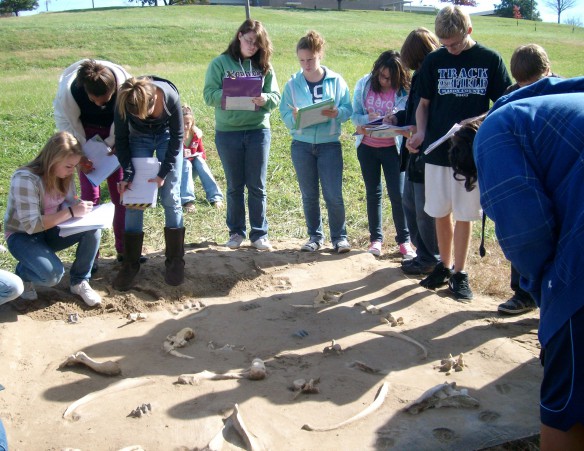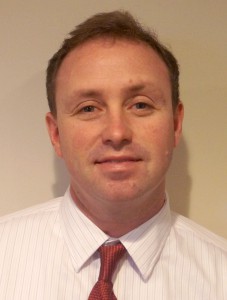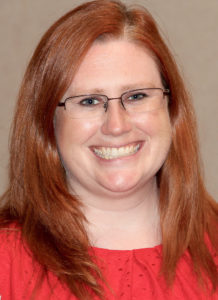
Students at Mason County Middle School analyze fossil evidence in the outdoor science center that was built after teacher Brian McDowell won a $10,000 grant from Toyota.
Photo submitted by Brian McDowell
By Brenna R. Kelly
Brenna.kelly@education.ky.gov
Brian McDowell likes to say he teaches in the margins.
In science, the margins are where two different habitats meet. The conditions there force the life forms to innovate and act differently than when they are not in the margins.
McDowell, a STEM teacher at Mason County Middle School, strives to take his students to the margins where they can learn differently – investigate, take risks, explore interdisciplinary connections, learn through projects and discover there is more than one right answer.
But teaching outside the lines often costs money most teachers don’t have.

Brian McDowell
“Teachers are good at taking the resources given to them and making them into something great for students,” McDowell said. “But what if teachers were making the choices? What if the teachers were getting the money?”
At the Let’s Talk Conference in Covington this summer, McDowell and Carly Baldwin, a science teacher at Boyd County High School, shared their secrets for getting funding to take students to the margins.
In 2007, McDowell had a vision for an outdoor science center to complement an outdoor classroom and pathway that had recently been built at his school thanks to a $20,000 donation.
In his mind, McDowell saw a dinosaur trackway, a stratigraphy column and a sand pit where students could dig for bones. After researching the costs, he realized his dream could become reality if he won a $10,000 Toyota Tapestry grant.
While working on the grant application, McDowell went to a Toyota Tapestry grant workshop during a science conference. He tried to explain the concrete dinosaur trackway and how the stratigraphy column could be built.
“They did not want to hear about what my dinosaur trackway was going to look like. They wanted to hear about what the impact on the students was going to be,” he said. “So I went home and I pretty much hit delete and started over.”
The new proposal focused on the students and how they would learn by doing. It didn’t mention concrete until the end in a listing of the cost of each feature, he said.
“If you are trying to inspire someone to give you $500 or $5,000, they don’t want to hear about computers,” he said. “They want to hear about the impact that it’s going to make on students.”
McDowell won the Toyota grant and his students now dig for skulls in the sand and use the tracks to infer the behavior of dinosaurs.
McDowell’s students could have learned about dinosaurs by using tracks two dimensional tracks projected on a screen. It’s not the same as following authentic tracks stamped into the concrete pathway outside.
“Instead of things being up on the wall, we can make kids really feel it,” he said.
When McDowell applied to a grant to buy Lego robots, he wrote about NASA’s rovers exploring Mars and how his students were like explorers using robots to pick up rocks on “Mars” and return them to Earth.
“I emphasized the impact, students are programming, they are having to a do a considerable amount of mathematics,” he said.
Though grants can be a good way secure funding, there’s no guarantee that every application will be a winner, McDowell said.
“I’ve not received way more grants than I have received,” he said.
Another approach to funding dream lesson is to build relationships with people who can help, he said. McDowell urged teachers to reach out to local companies that might have an interest in their subject area.
For McDowell, it was Stober, a Maysville company that makes gear boxes. McDowell worked with a Stober employee to create a project for his class. The company uses plates to connect gear boxes to other equipment. So McDowell’s 3D modeling class worked on designing the connector plates.
Then when the school wanted to expand its 3D printing capabilities, they asked for help from Stober, he said.
Another way to develop relationships is to invite the community into the classroom either in person or virtually so that they can see what you would do with the technology or why you need it, Boyd County’s Baldwin said.
Last year Baldwin set up a genius hour for her high school students every Friday. Students were allowed to work on passion projects for the entire period. One student learned to crochet, a group of boys built a potato cannon and another student wrote a presentation on feminism.
Students had to research their projects, keep a blog of their progress, develop a presentation and then present it while being filmed. The presentations were then uploaded to YouTube.
That allows Baldwin to share the student’s work virtually with anyone she’s asking to donate money.

Carly Baldwin
“Instead of saying, ‘Hey, I need 20 Chromebooks to do the research part,’ I can show them what they are going to be doing with Chromebooks,” Baldwin said.
Baldwin also recommended inviting community members to watch the presentations in the classroom to give the students feedback.
“If I had something I wanted to get funded, I could say, “Hey company, please come to my genius hour presentations and see what you think,’” she said.
Bringing in community members or business representatives to give feedback allows teachers to build relationships with the person without putting them on the spot, McDowell said.
“Usually the when we hear ‘community connection,’ first thing we think about is, ‘Hey, let’s bring in a speaker,’” he said.
But just asking someone to give feedback takes the pressure off, he said. The person doesn’t have to prepare a presentation or speak in front of the class, he said.
When McDowell had a student whose father was an engineer at Ford, the class video chatted with him about safety design in cars as they were preparing to protect eggs in an egg drop experiment.
“He didn’t show up in our school, except virtually,” McDowell said. “We really only needed him for like 10 minutes, so we scheduled it. He was still at his desk working and then he just popped on and talked to us for 10 minutes.”
McDowell’s students got the benefit of the engineer’s expertise, and McDowell made a connection that might be useful one day.
“The whole point is that we are developing this relationship,” he said. “So that when you have that ask, maybe you need five computers or whatever, then you have a relationship and a connection.”
Cheryl Peña, a teacher at Justice Elementary (Clark County), came to the session hoping to find ways to fund her school’s green team.
“I want to be able to take the kids out into the community and be able to bring that back to the school,” she said. She’d also like to find funding to start a school garden.
“I’ve already seen grants that I want to apply for,” Peña said. “That’s what’s so great about this conference, teachers bring their ideas that are tried and true and it’s something that you can walk right back to your classroom and implement.”
MORE INFO …
Brian McDowell Brian.McDowell@mason.kyschools.us
Carly Baldwin Carly.Baldwin@boyd.kyschools.us
FOR MORE FROM BRIAN MCDOWELL …
Designing partnerships and building our future






Leave A Comment